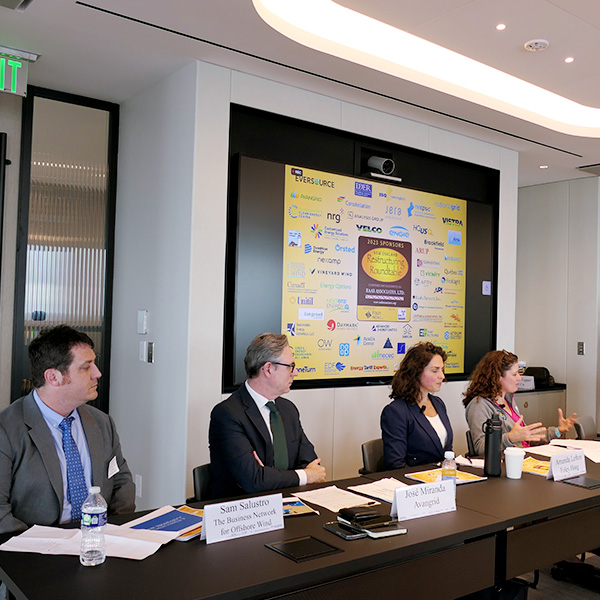
BOSTON — Building public support for clean energy projects and infrastructure will require increased community engagement and shorter timelines, a panel of energy experts told industry participants last week.
A variety of stakeholders, including industry insiders, government officials and climate advocates, gathered Friday at Raab Associates’ New England Electricity Restructuring Roundtable to discuss how the region can rapidly expand its clean energy infrastructure.
Stakeholders largely agreed that proactive and extensive community engagement is essential for building public buy-in for clean energy projects such as large-scale solar and onshore wind, as well as for new transmission infrastructure.
Eliza Donoghue, director of advocacy at Maine Audubon, said that more outreach to local communities is necessary to change the public narrative around renewable energy projects.
“Solar moratoriums are popping up all over the place in Maine,” Donoghue said. “Even die-hard climate advocates aren’t appreciating that rooftop solar alone isn’t gonna get us where we need to go.”
Donoghue said that focusing on local jobs can help win over communities that do not consider climate action to be a priority.
“We need to show the public using on-the-ground examples that we can have both,” Donoghue said. “We can rapidly deploy renewable energy resources at scale, and we can conserve our most high-value — and emphasis on high-value — natural resources.”
Don Jessome, CEO of Transmission Developers, Inc., agreed that extensive public engagement is an essential component of any successful project.
“You cannot do enough stakeholder engagement — it’s impossible,” Jessome said. “We will meet with anybody, anywhere, anytime. That’s the only way you’re ever going to get these projects built.”
At the same time, Jessome said, reducing procurement timelines is essential to limiting project risks and keeping costs low.
“Anything that can be done to cut those timelines is going to be incredibly important, because without it projects just won’t go forward,” Jessome said. “You just can’t take that risk.”
Massachusetts state Sen. Michael Barrett (D), co-chair of the Senate Joint Committee on Telecommunications, Utilities, and Energy, said that Massachusetts legislators lack information about the specific obstacles that are holding up project timelines at the state level.
Barrett said bills he has read in the current legislative session have failed to detail the regulatory roadblocks that are slowing down clean energy deployment. The only proposals include a “simple blanket suspension of the Massachusetts Wetlands Protection Act,” and a plan to “completely suspend review by regional planning agencies” such as the Cape Cod Commission and the Metropolitan Area Planning Council.
“We need more thought given to exactly where the state-level obstacles lay, and we need a concrete set of proposals,” Barrett said. “We need substitutes that are more thoughtful, more diagnostic, and more concrete.”
Offshore Development
Katie Dykes, commissioner of the Connecticut Department of Energy and Environmental Protection, said states need to “take a hard look at the competitive [request for proposal] and [power purchase agreement] model for driving investment in offshore wind.”
She said that Connecticut does not plan to abandon PPAs but is working to improve the process by aligning and coordinating procurements with other states, indexing PPA prices to account for inflation, and finding other funding mechanisms for the transmission costs that are currently part of the PPAs.
“Unique to offshore wind, we’re financing a bundled product of generation and transmission in one power purchase agreement, and so if there’s a way to pull costs out of a PPA through a regionally shared investment in transmission, I think that will help to mitigate some of these cost pressures,” Dykes said.
Dykes called on states to “engage in more conversations about sharing the costs — or investments as we like to say — in offshore wind on a regional basis,” adding that “transmission and interconnection costs are really well-suited for that kind of sharing.”
José Antonio Miranda, CEO of Avangrid Renewables, said flexibility in procurement contracts is essential to preventing unforeseen issues. Avangrid has moved to terminate its 1,200 MW PPA for the Commonwealth Wind Project in Massachusetts, while SouthCoast Wind Energy recently announced its intention to terminate its 1,200 MW proposal. (See Developer Seeks to Terminate SouthCoast Wind PPAs.)
Miranda said that a combination of supply chain constraints, inflation and rising interest rates have caused project costs to skyrocket, and that future contracts should account for these uncertainties.
“With these complex projects, you need to be flexible,” Miranda said. “You need to understand that something unexpected may happen, and it did happen the last two or three years.”
Amanda Lefton, policy director of Foley Hoag and the former director of the U.S. Bureau of Ocean Energy Management, said that while inflation is significantly impacting offshore wind, cost increases are “an industry-wide problem” affecting both renewable and fossil fuel projects.
“This is not because renewable energy is not viable; this is not because renewable energy can’t compete,” Lefton said. “This is because all energy projects are facing these challenges.”
Lefton said she expects states will put greater emphasis on project viability in future agreements, along with including inflation adjustment mechanisms.
The impact of global supply chain constraints on U.S. offshore wind will require creation of a massive domestic supply chain, said Sam Salustro of the Business Network for Offshore Wind.
“We’re going to see a ton more new manufacturing investments not only tied to procurements in New Jersey, New York, Massachusetts and Connecticut, but also unlinked investment decisions, so new factories are popping up regardless of whether a state is under a procurement process,” Salustro said.
He added that the industry will also need to invest in workforce development, which will rely on labor unions and state agencies.
Unions “are already spending millions and millions of dollars setting up new training facilities in union halls all across America to make sure that their members are ready,” Salustro said.


